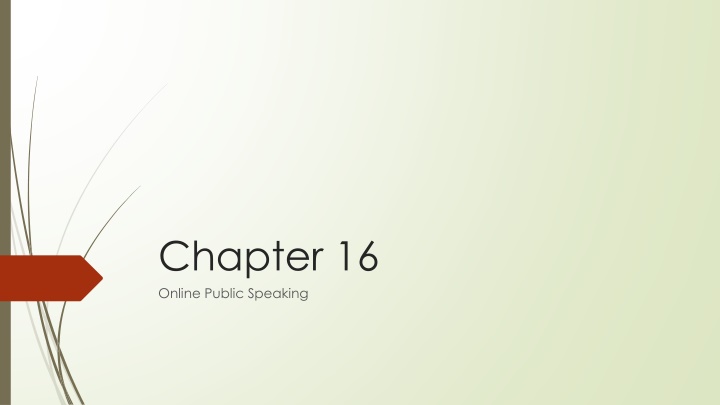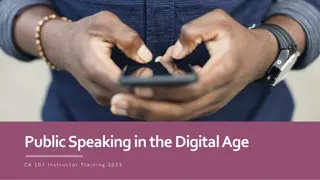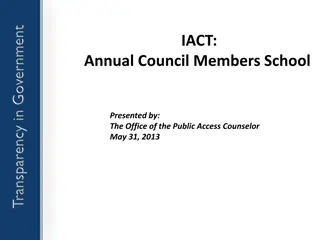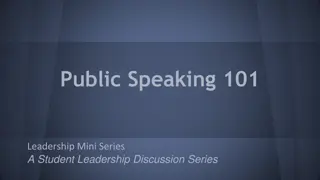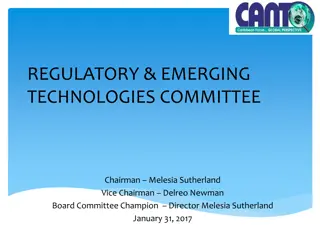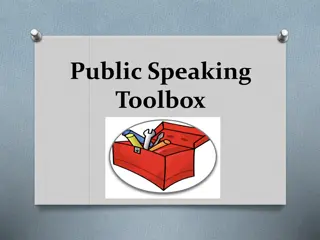Basics of Online Public Speaking: Emerging Medium & Best Practices
Online public speaking, an emerging medium, involves synchronous & asynchronous communication. Explore strategies and principles for effective digital oratory on new media platforms, benefiting from real-time feedback but with inherent technological risks.
Download Presentation

Please find below an Image/Link to download the presentation.
The content on the website is provided AS IS for your information and personal use only. It may not be sold, licensed, or shared on other websites without obtaining consent from the author.If you encounter any issues during the download, it is possible that the publisher has removed the file from their server.
You are allowed to download the files provided on this website for personal or commercial use, subject to the condition that they are used lawfully. All files are the property of their respective owners.
The content on the website is provided AS IS for your information and personal use only. It may not be sold, licensed, or shared on other websites without obtaining consent from the author.
E N D
Presentation Transcript
Chapter 16 Online Public Speaking
Learning Objectives ? Explore digital public speaking as an emerging medium ? Define synchronous and asynchronous communication ? Strategize best practices for online speaking
Online Public Speaking New media and digital technologies have expanded both our access to public speakers and our platforms to speak and reach new audiences. Consider the following: YouTube a global video sharing service has more than 1.8 billion monthly users (Gilbert, 2018) Webinars, video conferences, and digital speakers have permeated professional industries. When the Covid-19 pandemic made it was too dangerous to gather in person, people began using technologies such as Zoom and Microsoft Teams to host virtual classes, meetings, and gatherings. ? ? ? Many organizations and workplaces continue to use online platforms for meetings and presentations because its easier for people to join a Zoom call from their office or home than it is to physically meet in one location.
Basics of Online Public Speaking Online public speaking also knowns as digital oratory is a thesis-driven, vocal, embodied public address that is housed within (online) new media platforms (Lind, 2012, p. 164). Purpose, synchronicity, and audience are all key factors in successful online public speaking. Purpose Like other forms of public speaking, digital oratory requires a thesis statement, and the purpose of your speech will dictate how you craft the information that you re going to present. Consider the difference between leading live webinar via Zoom or recording an instructional video explaining how to use a new piece of technology and uploading it to YouTube. Each situation has different purposes as well as expectations about what should be included.
Synchronicity Synchronicity Synchronicity describes whether your digital oratory will be delivered live or recorded for people to use later. If your audience is listening to you speak in real time, you are speaking synchronously. You are speaking asynchronously if your speech is recorded and your audience views it later.
Synchronous Online Public Speaking In synchronous online speaking you have one chance to create a clear message, so it s imperative that your content and information are crafted for clear understanding. In synchronous speaking, many of the same face-to-face speaking principles apply, so you may be more comfortable in adopting and applying face-to-face public speaking strategies, including integrating live audience feedback. Benefits It s common in synchronous online speaking for audiences to post questions or provide live feedback, allowing you to adjust your content and fill in gaps. Disadvantages If there is a technological mishap, however, you can t correct it later. The mishap also happens in real time, which can influence your credibility as a speaker.
Asynchronous Online Public Speaking Benefits In asynchronous speaking, you can control the content more easily because you can re-record the material to fix any technological errors. Disadvantages You cannot get live feedback from your audience, so you may be unaware if there s a key question or issue that needs answering
Audience In traditional public speaking, the audience is often limited to those individuals who show up for the event the audience is explicit or discrete. In online speaking, you may have a discrete or dispersed audience. These different audience types, along with synchronicity, alter how audience engagement can occur. Dispersed audiences are more difficult to determine. For example, It can be difficult to make specific references or calls to action because geographic locations may alter what individuals are able to do. There s an increased risk that audience members won t view your digital speech due to information overload. If you re posting a digital speech with a less-defined audience, the first few lines the attention getter become crucial to hook them into watching.
Rehearsing to Speak Online Be aware of the speaking context, including the categories mentioned in the previous section: purpose, synchronicity, and audience for effective rehearsal. Use this information to rehearse under the conditions that you ll speak. Verbal Delivery Verbal delivery is key in a digital speech particularly webinars or web conferencing where your vocals overlay a slideshow and your body isn t visible to an audience. Enunciation, punctuation, rate, and pauses are important for maintaining your audiences attention.
Verbal Delivery Hacks Audio-record yourself during rehearsal on your smartphone or other device, then replay the recording and think critically and honestly about whether your voice is listless, flat, or lacks energy. Some experts suggest that web conference speakers stand to approximate the real speaking experience, as we have lower energy levels when we sit. Rehearse with any technology including a microphone that will be present during your online speech. Alter your projection level so that your voice is audible over the microphone. If you are recording your speech, practice to see how the recording device will pick up sound including your voice and other noise around you. Find a quiet location to practice and present or record your online speech. Remember that extra noises such as barking dogs, toilets flushing, or lawn crews working nearby is distracting and diminishes your credibility as a speaker.
Non-Verbal Delivery Hacks When rehearsing your nonverbal delivery, ask, what s visible in the video? As you prepare to rehearse, be conscious of where the camera will be. Will there be just one or several? How far away is the camera? Being aware of where those cameras are is key to rehearsing your eye contact and facial expressions. Eye contact is still a key part of a digital speech. Make eye contact with the audience from time to time to create a connection with them. Whether your speech is synchronous or recorded (and/or asynchronous), view the camera as your audience substitute.
Background and Lighting Hacks Your background is also part of your video s nonverbal aesthetics. Consider how the background might translate to your audience. Is it messy and distracting? Is it a white background? Avoid wearing white and looking as if you are disappearing into the walls. Are there windows behind you with bright light streaming through, making you almost invisible? Can you close the blinds or curtains or move? Can you set up a ring light to offset the light coming through outside sources? Does your videoconferencing software have filters that blur out imperfections that might otherwise be heightened by visual photography?
Camera Positioning Hacks Because your facial expressions and body language are also visible in a digital speech, pay attention to how the camera(s) is positioned. Don t position the camera so closely that your head fills the frame, or so far away that you are a tiny object in the frame. To look your best, position the camera so that you are viewed from above from between 15 to 30 from eye level. Filming yourself at eye-level might make your facial features appear flat, while filming yourself from below eye level gives the impression that you are towering over your audience. If your camera is in your laptop computer, try balancing it on a small stack of books to achieve an optimal level.
Wardrobe, Hair, and Makeup Hacks Wear appropriate clothing on all parts of your body. Dress as if the audience might see your entire body to avoid embarrassment. Make sure that your clothing looks good on camera in terms of color and lighting in your setting. Avoid noisy jewelry that jingles if you move. Look just as you would in the same setting if you were meeting face to face. Style your hair the way you would if you were meeting the is audience in person. If you normally wear cosmetics in the office, wear them on camera as well.
Dress Rehearsal Hacks Effective rehearsal occurs under the conditions that you ll speak. Videorecord your rehearsal and evaluate Whether some gestures or facial expressions look exaggerated, If there is too little light for the viewer to clearly see your body language and facial expressions or so much that these elements of your presentation are washed out Whether your clothing and overall appearance are professional or distracting
Additional Online Presentation Tips Make sure you will not be interrupted by people or other noises during the web conference. Have notes and anything else you need at hand. While you can use a computer to display them, be conscious of your audience s ability to see you reading. If you can be seen, be seen use the technology to your advantage so that you are not an entirely disembodied voice talking over slides.
Online Presentation Aids Are you certain that you need a presentation aid? Don t use a visual aid to avoid being seen. The audience will be much more interested in your embodied presentation. Do you know how to share your visual aid via the digital platform you will be speaking through? Practice beforehand so that you know what your audience will see as well as how to quickly switch from your screen to the visual aid and back again. Do you need to provide the visual aid during your presentation, or is it something you could email to your audience beforehand? Sending your visual aids ahead of time allows your audience to feel acquainted with the information and can save you from struggling with an additional technological component.
Rehearsing Your Online Speech: Final Thoughts Rehearse under the conditions that you ll speak. Be confident that you re aware of the technology you will need, where it will be placed, which technology that you are responsible for running, and how your embodiment of information translates.
